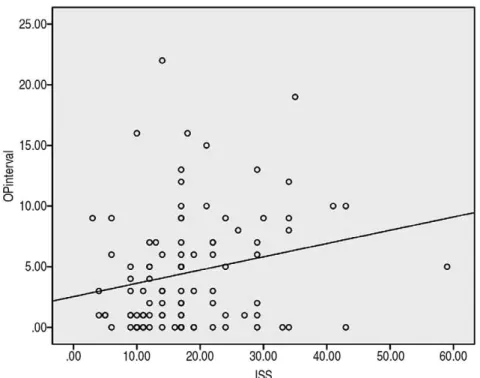eISSN 2287-1683 pISSN 1738-8767 Journal of Trauma and Injury Vol. 29, No. 4, December, 2016 http://dx.doi.org/10.20408/jti.2016.29.4.151
─ 151 ─
� Original Article �
� Address for Correspondence : Seung Hyun Kim, M.D.
Department of Orthopaedic Surgery, Yonsei University College of Medicine, 50 Yonsei-ro, Seodaemun-gu, Seoul 03722, Korea
Tel : 82-2-2228-2135, Fax : 82-2-313-8289, E-mail : sseunghk@yuhs.ac
Submitted : November 16, 2016 Revised : December 1, 2016 Accepted : January 20, 2017
Time to Surgery and Injury Severity Score
Chang Seon Oh, M.D.
1,3, Jae Gil Lee, M.D., Ph.D.
1,2, Seung Hyun Kim, M.D.
1,31Department of Orthopaedic Surgery, Yonsei University College of Medicine, Seoul,
2Department of Surgery, Yonsei University College of Medicine, Seoul,
3Trauma Training Center, Severance Hospital, Yonsei University Health System, Seoul, Korea
Purpose: To evaluate the association between time to surgery and injury severity score (ISS).
Methods: Medical charts and records were reviewed for polytrauma patients who underwent trauma surgery from November 2014 to March 2016. The patients were divided into two groups based on the ISS.
Results: Among the 217 operated patients, 22 patients underwent first and second surgery. The patients with an ISS over 17 (mean 13.0 days) had a longer interval between surgeries than patients with an ISS of 17 or less (mean 7.5 days) (p=0.031). One hundred and twenty-one patients only underwent elective surgery and there is a positive correla- tion between ISS and time to elective surgery (p<0.028, Pearson’s correlation coefficient=0.224). Seventy-four patients underwent emergent surgery only. Among these, the patients with an ISS of 17 or less underwent general surgery (86%) but the patients with an ISS more than 17 underwent neurological surgery (47%).
Conclusion: Patients with high ISS need critical care during the preoperative and postoperative period. [ J Trauma Inj 2016; 29: 151-154 ]
Key Words: Polytrauma, Injury severity score (ISS), Surgery
─ 152 ─
- Journal of Trauma and Injury Vol. 29, No. 4 -
Table 1. General characteristics of patients
ISS 17 (N=119) ISS > 17 (N=98) p value
Age 45.3 50.6 0.301
Gender
Male 80 71 0.105
Female 39 27 0.204
Mechanisms of injury
Traffic crashes 75 72
Pedestrian (22, 30) (33, 46)
Motorcycle (28, 37) (12, 17)
In car (25, 33) (27, 37)
Fall 24 20
Etc. 20 06
Table 2. Differences in clinical course from emergent to elective operation
ISS 17 ISS > 17 p value
OP interval 7.5 13.0 0.031
Mean ICU stay 8.3 16.9 0.109
─ 153 ─
Chang Seon Oh, et al. Time to Surgery and Injury Severity Score
Fig. 1. Correlation between ISS and time to elective surgery (OP interval).
REFERENCES
01) Butcher N, Baloqh ZJ. The definition of polytrauma: the need for international consensus. Injury 2009; 40: S12-22.
02) Tohira H, Jacobs I, Mountain D, Gibson N, Yeo A.
Comparisons of the outcome prediction performance of injury severity scoring tools using the abbreviated injury scale 90 update 98 (AIS 98) and 2005 update 2008 (AIS 2008). Ann Adv Automot Med 2011; 55: 255-65.
03) Kuhls DA, Malone DL, McCarter RJ, Napolitano LM.
Predictors of mortality in adult trauma patients: the physiolog- ic trauma score is equivalent to the trauma and injury severity score. J Am Coll Surg 2002; 194: 695-704.
04) Jo MJ, Lee SH, Cho SJ, Yeom SR, Han SK, Park SW, et al.
Why do multiple-trauma patients stay longer in the intensive care unit?; a comparison of injury severity score and the num- ber of injured regions. JTI 2013; 26: 47-52.
05) Toroyan T. Global status report on road safety. Inj Prev 2009;
15: 286.
06) World Health Organization (WHO). World health statistical information system [Internet]. Reviewed 2016. Available from: http://www.who.int/mediacentre/factsheets/fs358/en/.
07) George RL, McGwin G Jr, Windham ST, Melton SM, Metzger J, Chaudry IH, et al. Age-related gender differential in outcome after blunt or penetrating trauma. Shock 2003; 19:
28-32.
08) Moore EE. Trauma systems, trauma centres and trauma sur- geons: opportunity in managed competition. J Trauma 1995;
39:1-11.
09) Remick KN, Schwab CW, Smith BP, Monshizadeh A, Kim PK, Reilly PM. Defining the optimal time to the operating room may salvage early trauma deaths. J Trauma Acute Care Surg 2014; 76: 1251-8.
10) Cantu RV, Graves SC, Spratt KF. In-hospital mortality from femoral shaft fracture depends on the initial delay to fracture fixation and Injury Severity Score: a retrospective cohort study from the NTDB 2002-2006. J Tauma Acute Care Surg 2014; 76: 1433-40.
11) Meril GJ. Medical consultation in the patient with multiple trauma. Med Clin North Am 1993; 77: 493-507.
─ 154 ─
- Journal of Trauma and Injury Vol. 29, No. 4 -

